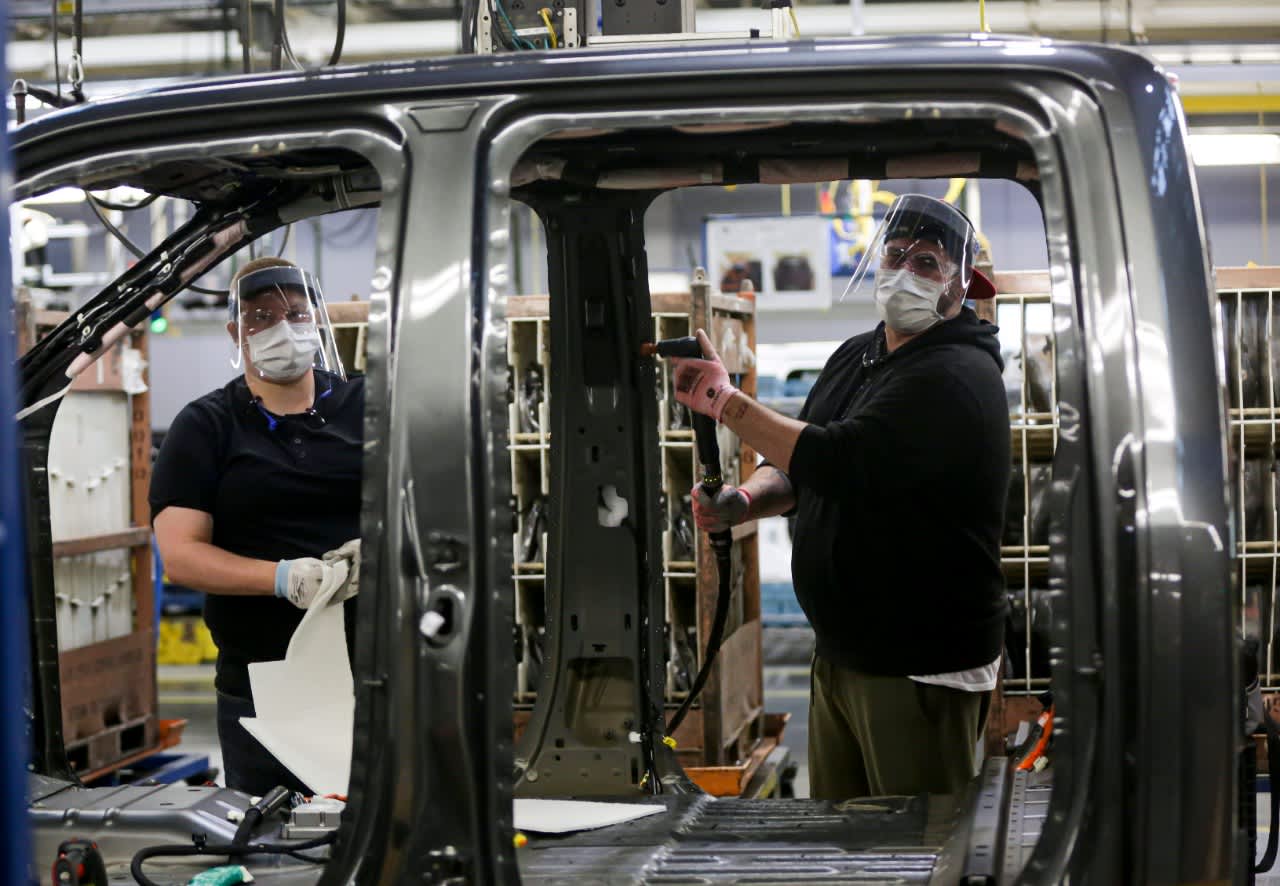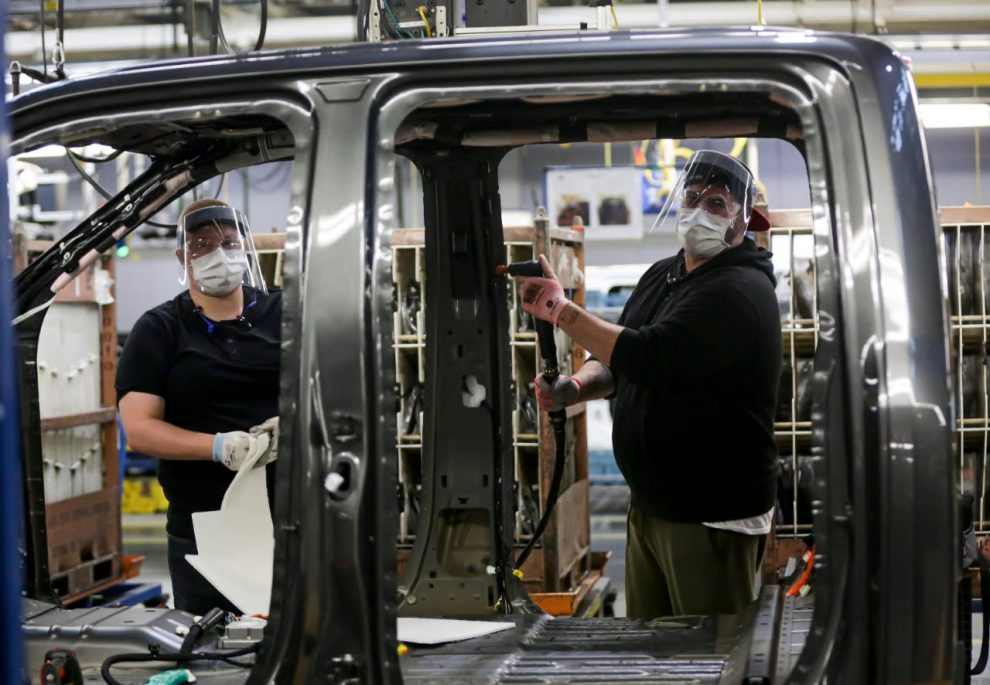
Ford started resuming vehicle production in the U.S. on May 18, 2020 with new coronavirus safety protocols such as health assessments, personal protective equipment and facility modifications to increase social distancing.
Ford
The coronavirus pandemic has brought the U.S. automotive industry to a standstill unlike any event has since World War II. Factories were shuttered, hundreds of thousands of employees were laid off and no new vehicles rolled off U.S. assembly lines for roughly two months starting in late March.
BofA Securities analyst John Murphy described the second quarter as “likely to be the toughest in modern history” for the automotive industry, as companies “grappled with close to a zero revenue environment for a few months.”
Other investors and executives with the automakers have called the second quarter “unprecedented,” and likely the worst three months of the year.
The Detroit automakers this week are all expected to report losses. General Motors, which is the first major U.S. automaker reporting earnings for the quarter, is forecast to lose $2.9 billion when it releases its results Wednesday morning, according to a consensus of analysts surveyed by FactSet.
Ford Motor, which reports its second-quarter earnings after the markets close Thursday, is expected to say it lost $4.9 billion. Analysts estimate that Fiat Chrysler, which reports Friday morning, lost $2.3 billion.
As the Detroit automakers report second quarter results starting Wednesday with GM , earnings aren’t the only thing investors will be watching. Here are others:
Cash burn and liquidity
Cash remains king for the automotive industry as companies attempt to manage through the crisis and recoup lost profits and ramp up vehicle production.
“Expectations are obviously extremely low given volumes were so bad,” Morningstar analyst David Whiston told CNBC. “The biggest thing I care about is how bad was the cash burn.”
GM said it expected to spend between $7 billion and $9 billion in the second quarter. That was partially contingent on the rate of monthly U.S. sales dropping to 8 million to 10 million, which only occurred in April. That could mean slightly less cash burn for GM, according to Whiston.
The coronavirus pandemic cost GM $1.4 billion in first quarter earnings before interest and taxes. The automaker had $33.4 billion in automotive cash to begin the second quarter.
Ford burned through $2.2 billion in cash during the first quarter. It did not provide a forecast for the second quarter other than it expected adjusted earnings before taxes to be a loss of more than $5 billion. It had automotive liquidity of $35.1 billion to end the first quarter.
Fiat Chrysler spent about $5.5 billion (5.1 billion euros) in cash during the first quarter related to the pandemic.
GM reported a $294 million profit in the first quarter compared with losses of $2 billion for Ford and $1.8 billion for Fiat Chrysler.
Debt
Both GM and Ford roughly doubled their automotive debt to $30 billion during the first quarter to help bolster their balance sheets and get through the coronavirus pandemic.
Wall Street will be watching how quickly the companies can repay those liabilities and return to normal debt levels.
“Ultimately what I want to know is how much of the debt can they pay off by year-end,” Whiston said. “What’s the capital structure going to look at the end of the year?”
2021 Ford F-150 Limited
Ford
Reuters reported last week Ford has obtained commitments from enough relationship banks to extend the maturity of at least 90% of $5.35 billion of revolving loans for one year.
Fiat Chrysler had about $16.7 billion (14.2 billion euro) in debt to end the first quarter, up from $15 billion (12.8 billion euro) to begin the year.
Inventory levels
Automakers have been producing vehicles around the clock at some plants to restock dealer inventories with highly profitable pickups and SUVs, which have remained in high demand through the pandemic.
The coronavirus pandemic caused rolling shutdowns of auto plants across the globe starting in the first quarter and continuing through much of the second. Factories in the U.S. began reopening in mid-May. Automakers are continuing to ramp-up production.
“We believe the key theme for the Ford/GM 2Q EPS calls will be how they are pivoting from defense to offense amid improved end market stability,” Credit Suisse analyst Dan Levy wrote in an investor note last week.
United Auto Workers members leave the Fiat Chrysler Automobiles Warren Truck Plant after the first work shift, Monday, May 18, 2020, in Warren, Mich.
Paul Sancya | AP
Another full or partial shutdown of plants would be devastating to the industry.
A major concern for the automakers is high absenteeism hurting production. So many employees are missing work that it’s causing issues on production lines in states where Covid-19 cases are surging.
Recovery
Many investors are writing off the second quarter and looking for any insight on how long it will take the industry to recover and return to “normal.”
“Given the headwinds in 2020, most investors (or to be fair, the few who care about legacy OEMs) are looking to 2021,” Barclays analyst Brian A. Johnson wrote in an investor note, calling the second quarter a “throw-away.”
Morningstar doesn’t expect global demand to reach “more normal levels” until 2023.
Analysts do not expect the automakers to reinstate earnings guidance for the year as it remains extremely volatile.
Potential problems for the remainder of the year include increases in Covid-19 cases leading to full or partial shutdowns of plants; leveling or declining consumer demand; and parts shortages, amid other potential issues.
Cost-cutting
Wall Street is anxious to hear whether the automakers have identified any additional cost-cutting opportunities as a result of the pandemic.
Fiat Chrysler CEO Mike Manley told investors when discussing first quarter earnings that the company had identified about $2.2 billion (2 billion euros) in operational cuts for this year as it reevaluates its global business due to Covid-19. That’s in addition to reducing capital expenditures by about $1.1 billion (1 billion euros), he said.
Ford is in the midst of an $11 billion restructuring plan through the early 2020s, which the company said remains on track. Ford did not release a target for any additional savings but said it has lowered operating costs and reduced capital expenditures, among other efforts to cut costs.
PSA CEO Carlos Tavares and FCA CEO Mike Manley shake hands after signing a combination agreement that will lead to the creation of the world’s fourth-largest global automaker in terms of annual sales (8.7 million vehicles).
FCA
“There’s that one truth, right? Don’t waste a crisis,” Ford CEO Jim Hackett told investors when discussing the company’s first quarter earnings
GM has “aggressively reduced” its ongoing costs and used “a zero-based budgeting approach,” CFO Dhivya Suryadevara told investors in April. She said notable actions included “significant cuts to our advertising and other discretionary spend, compensation deferments and certain employee furloughs.”
GM, according to Suryadevara, said it expected ongoing cash costs, including tax, interest, and pension, to be approximately $2 billion per month.
She said GM’s previously announced multiyear cost-cutting plans to eliminate about $6 billion in spending through 2020 remained “on track,” including $300 million in the first quarter of this year.
“The actions we’re taking position us to come out of this downturn strong and allow us to capitalize on the recovery and future opportunities,” Suryadevara said.





